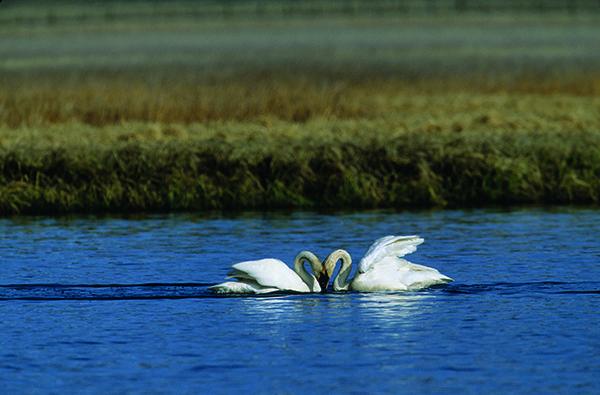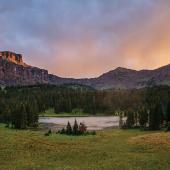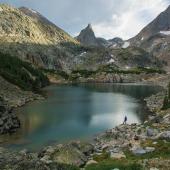Swan Lake
October frosts your breath as you float near a kaleidoscope of thousands of brilliant white swans. Not hundreds, but thousands. They are beautiful, large birds, pure-white in adulthood with black feet and beaks, an eight-foot wing span, and long, curving, romantic necks. Whenever you move, a wave of fluttering attention passes through the flock, like a gust of wind against thick fur or excited fans at a football game. Half-sized grayish youngsters practice their newly learned flight and the sonorous low-pitched bugle call Trumpeter Swans are named for.
In the early 1900s, Trumpeter Swans were believed extinct, their snow-white feathers perfect for lady’s powder puffs and decorative hats, and their 30-pound size for starving local bellies. Migrating flocks were easy targets, but a handful of nonmigratory birds survived, hidden 50 miles west of Yellowstone Park in remote mountain lakes that stayed open over winter and provided plant food during the months of fierce cold.
The introverts of the swan world, Trumpeters prefer isolated homes and remain in small family groups rather than large boisterous flocks. They have an overriding need for seclusion and an extreme sensitivity to human activity, and will abandon nests and even lakes because of human contact. Good winter habitat is crucial to their prosperity. The availability of an adequate supply of aquatic plants (20 pounds wet weight per swan per day) and open water through the winter not only determines survival rates, but influences springtime breeding productivity.
In 1935, shortly after 69 Trumpeters were discovered there, the 45,000-acre Red Rock Lakes National Wildlife Refuge was established as a general waterbird habitat. Biologist Jeff Warren calls the refuge “one of the most spectacular migratory bird resources in North America, [sitting] on the cusp between the Pacific and Central flyways.” The rugged Centennial Mountains provide a dramatic backdrop for a diverse marsh-prairie-montane environment, which ranges from 6,600 to 10,000 feet in elevation and encompasses 14,000 acres of lake and marshland.
Little more than seven feet deep, the shallow Red Rock lakes facilitate abundant aquatic plant and invertebrate growth, welcome food sources for the 232 species of birds known to pass through. The inherent solitude and diverse habitat of this extremely remote but teeming refuge was ideal for reestablishing a population of the swans who survived there.
By the early 1990s, after decades of nurturing, the Trumpeter flock had grown so large that experts became concerned over the possibility of catastrophic losses from a single event, such as disease. While discontinuing winter grain feeding to establish a natural swan-to-food balance, scientists began capturing and moving swans to other locations in an attempt to reestablish migration and southern wintering habits.
Today the nonmigratory Trumpeter flock persists in the refuge, but in the fall it is joined by hundreds of migrating Trumpeters from the north, as well as thousands of nearly identical Tundra Swans. In fact, for decades a large flock of existing migrating Trumpeter Swans were wrongly identified as Tundra Swans, the main differences being slight—size, beak coloration, head bobbing habits, group size. According to Warren, both breeds have a yellow “lore” near their beak, though the Trumpeters' are generally larger; and sometimes Trumpeters show a “red grin” from their red lower mandible. The only absolute identification is their calls. Tundra Swans have high, somewhat whistling voices, while Trumpeters' are clear, deep, and resonant.
During fall migration large flocks of Tundra swans and smaller Trumpeter families intermingle in a raucous white swath across the icy blue water of the Refuge. Both lakes are open to canoes and kayaks (the upper lake beginning July 15 and the lower lake from September 1) until the lakes freeze over, with some hunting allowed on the lower lake. In late September, Trumpeter parents might be seen encouraging their awkward cygnets (chicks) to fly, but the last two weeks of October generally offer the best overall viewing with the largest congregations of swans. Timing is, however, largely weather dependent, as is vehicle access. Phoning ahead for bird and road reports is highly recommended.
For more information call Red Rock Lakes National Wildlife Refuge at (406) 276-3536 or visit fws.gov/redrocks/.
Joanne Wilke’s nonfiction/memoir book entitled Eight Women, Two Model Ts, and the American West will be released by the University of Nebraska Press in December 2007.









